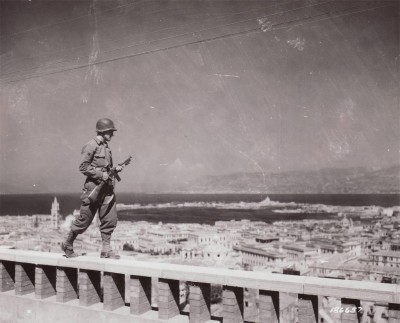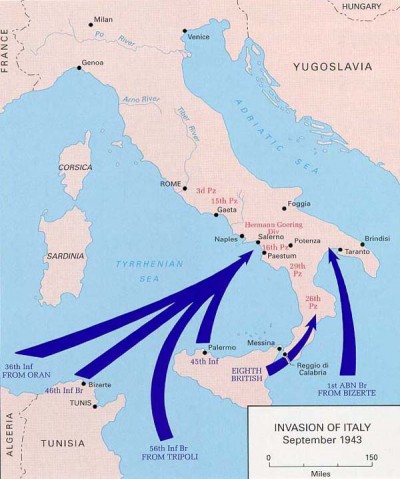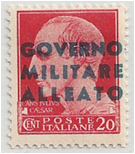ALBUM – view my AMG Occupation of Naples album
TRANSITION CHART – Italy after unification
Region: Italy Area
Group: WW2 Occupations of Italy
Classification: Occupations
Prior Regime: Italy
Key Dates:
1943, Jul 10 – American and British military landed on Sicily
1943, Sep 2- Allied invasion of Southern Italy began
1943, Sep 8- King Victor Emmanuel announced announced armistice with the Allies
1943, Oct 7 – British forces took the city of Naples
1944, Jun 4 – Allied forces take Rome
Following Regime: AMG Occupation of Italy
Scott Catalogue: (Italy, AMG) #1N10-1N12
Pick Catalogue: (Italy) #M10-M23
History

The defending German and Italian forces were unable to prevent the Allied capture of the island, but succeeded in evacuating most of their troops to the mainland, the last leaving on 17 August Army landed in the ‘toe’ of Italy in Operation Baytown the day that the new Italian government agreed to an armistice with the Allies. The campaign in Italy was merely a springboard for a continued push into the rest of Italy. On 2 Sept, 1943, a small Allied force had landed on the “heel” of Italy, quickly taking the ports of Brindisi & Taranto. The following day, Montgomery’s Eighth Army crossed the Straits of Messina & landed in Calabria, on the “toe” of Italy.
Realizing the Italian Army would be unable to repel an advancing army, the Italian Grand Council of Fascism rejected Mussolini with a vote of no confidence and asked King Victor Emmanuel to resume his full “constitutional powers”. The King had Mussolini imprisoned, and privately began negotiating an armistice with the Allies. On 8 Sept, 1943, as the Allies were moving into Southern Italy, the King publicly announced an agreement with the Allies without prior notice to his armed forces. Germany, expecting the announcment, quickly disarmed and captured Italian forces. Many of those troops did not surrender and fought the Germans, while others joined the Allied forces.
On 8 Sept, 1943, as the Allies were moving into Southern Italy, the King publicly announced an agreement with the Allies without prior notice to his armed forces. Germany, expecting the announcment, quickly disarmed and captured Italian forces. Many of those troops did not surrender and fought the Germans, while others joined the Allied forces.
On 12 Sept, 1943, the Germans rescued Mussolini from imprisonment, and on 23 Sept, he established the Italian Social Republic, a fascist state in northern Italy. While never more than a German puppet, it was largely dependent on German troops to maintain order, and was only recognized by Germany and its occupation
By early October, Allied forces had captured Naples and most of southern Italy, establied control of the territory. From this point, it took 9 months and four major campaigns before the allied troops were able to march into Rome in June, 1944.
Stamps
 ALBUM
ALBUM
In the chaos of war, restoring the postal system is usually not high on the list of priorities by occupying troops. On 10 Dec 1943, the 20c, 35c, and 50c issues of the Italian Imperial series were overprinted GOVERNO MILITARE ALLEATO in letterpress in blue (20c), and red (35c, 50c) for postage use in Southern Italy. The stamps were overprinted in Naples.
In addition to the Naples zone, these stamps were issued in Puglia because of the need for postage stamps. These issues were not very popular with Italian Authorities, who had moved south after their armistice with the Allies. Postal use of he stamps (other than philatelic) are rare.
Banknotes
In 1943, two printings of Italian occupation money was issued by the Allies. The first was issued in 1, 2, 5, 10, 50, 100, 500, 1.000 lire, and the second in 5, 10, 50, 100, 500, 1.000 lire.
Links
Liberation Trilogy – The liberatation of Europe in WW2
AMG Stamps at Alphabetilately




